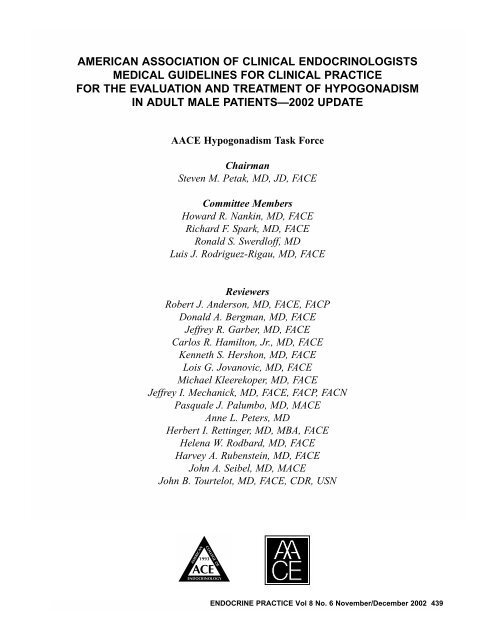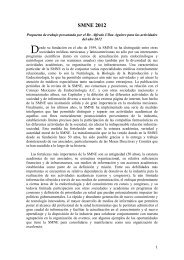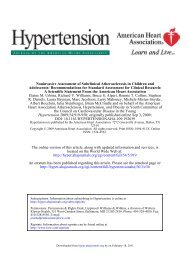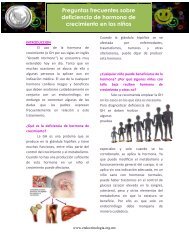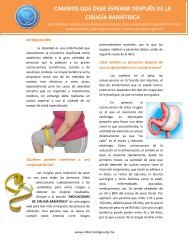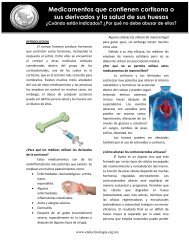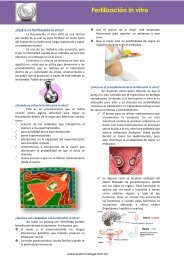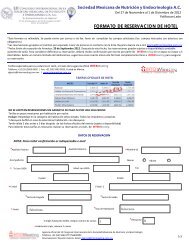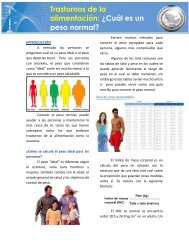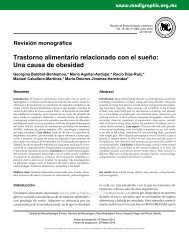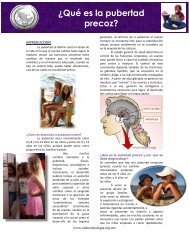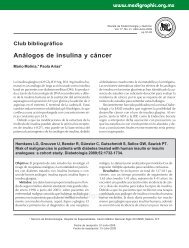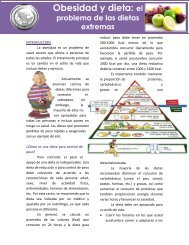Guidelines for Clinical Practice for Evaluation and Treatment
Guidelines for Clinical Practice for Evaluation and Treatment
Guidelines for Clinical Practice for Evaluation and Treatment
You also want an ePaper? Increase the reach of your titles
YUMPU automatically turns print PDFs into web optimized ePapers that Google loves.
AACE Hypogonadism <strong>Guidelines</strong>, Endocr Pract. 2002;8(No. 6) 443most accurate results will be obtained with these highlysensitive assays (5). Currently, many assays <strong>for</strong> gonadotropinslack the sensitivity to detect values below thenormal range, unlike the modern thyrotropin assays <strong>for</strong>thyroid disease. Additional studies, such as gonadotropinreleasinghormone (GnRH) testing, by an endocrinologistmay help in the further assessment of these patients.Both FSH <strong>and</strong> LH are secreted in short pulses. FSHhas a longer half-life than does LH <strong>and</strong> is more likely toprovide adequate results on a single blood sample. In addition,most patients with progressive hypogonadism willhave increased FSH levels well be<strong>for</strong>e LH levels increase.Because LH has a shorter half-life than does FSH, errorsmay be introduced in measurements made on single samples.Pooled samples <strong>for</strong> LH done 20 to 30 minutes apartare more accurate than single-sample determinations(albeit less convenient). Persistent borderline values maybe further evaluated with dynamic endocrine testing.These tests may include the GnRH stimulation test, theclomiphene stimulation test, <strong>and</strong> the human chorionicgonadotropin (hCG) stimulation test. These specialized,dynamic studies should be conducted <strong>and</strong> interpreted byan endocrinologist <strong>and</strong> may have limited clinical value.Dynamic TestsGnRH Stimulation Test.—In the GnRH stimulationtest (11,12), intravenous injection of 100 µg of GnRHcauses serum LH levels to increase threefold to sixfoldduring a period of 30 to 45 minutes <strong>and</strong> FSH levels toincrease between 20 <strong>and</strong> 50%. Various degrees of primarytesticular failure cause higher than expected peak values<strong>for</strong> LH <strong>and</strong> FSH. Men with hypothalamic or pituitary diseasemay have a reduced or normal response that is ofteninadequate <strong>for</strong> distinguishing between a pituitary <strong>and</strong> ahypothalamic disorder. If the pituitary gl<strong>and</strong> is primedwith repeated doses of GnRH, this stimulation test mayprovide a more sensitive <strong>and</strong> reliable result.Clomiphene Stimulation Test.—In the clomiphenestimulation test, 100 mg of clomiphene citrate is given <strong>for</strong>5 to 7 days as an evocative test of the hypothalamic-pituitaryaxis. Clomiphene acts by interrupting the negativefeedback loop <strong>and</strong> thereby stimulating release ofgonadotropin from the pituitary. A doubling of LH <strong>and</strong> a20 to 50% increase in FSH are normal results indicative ofan intact hypothalamic-pituitary response (13).hCG Stimulation Test.—Various protocols are used<strong>for</strong> hCG stimulation testing. In general <strong>for</strong> postpubertalmale patients, a single dose of hCG (5,000 IU intramuscularly)is administered, <strong>and</strong> pretherapy <strong>and</strong> 72-hour posttherapytestosterone measurements are done (some protocolsuse 1,000 to 4,000 IU of hCG or multiday dosing) (14).Prolactin LevelIn men with acquired hypogonadotropic hypogonadism,who usually have a reduced libido <strong>and</strong> impotence,a prolactin level should be determined to evaluate <strong>for</strong> thepresence of a prolactinoma or other cause of hyperprolactinemia.High prolactin levels can reduce GnRH <strong>and</strong>testosterone levels. In addition, a high prolactin level canreduce libido <strong>and</strong> potency even in men treated with therapeuticdoses of testosterone. About 5% of men who complainof impotence will have an increased prolactin level(15). Further endocrinologic evaluation with magnetic resonanceimaging (MRI) scanning of the pituitary gl<strong>and</strong> isindicated <strong>for</strong> unexplained hyperprolactinemia.Semen AnalysisA semen analysis (12) is the primary test to assess thefertility potential of the male patient. Semen should be collectedby masturbation after 2 to 5 days of abstinence <strong>and</strong>evaluated within 2 hours. Variability between specimensis common; with low or borderline samples, follow-upconsisting of evaluation of three or more samples shouldbe done during a 3-month period. A fertile sample isusually associated with a motility of more than 50% <strong>and</strong> asperm count that exceeds 20 million/mL (16). In general,semen volume should range from 1.5 to 6 mL.Morphologic features should be examined <strong>for</strong> abnormalities.A fructose test should be done on a semen sampleshowing azoospermia. Because fructose is secreted by theseminal vesicles, absence of fructose may indicate completeobstruction of the ejaculatory ducts or congenitalabsence of both vasa deferens <strong>and</strong> both ejaculatory ducts.Most often, a semen analysis is done in an otherwiseasymptomatic man during the course of an infertility evaluation.For such an assessment, a semen analysis shouldbe done early to determine appropriate further evaluation<strong>and</strong> therapeutic options.Other StudiesBone DensitometryBecause hypogonadism frequently results in low bonedensity <strong>and</strong> increased fracture risk, baseline hip <strong>and</strong> spinebone densitometry studies should be per<strong>for</strong>med to assessthe initial situation <strong>and</strong> allow future interventions to bebased on any deterioration in bone density that may occurover time. Such baseline studies are especially importantin men treated <strong>for</strong> prostate cancer <strong>and</strong> rendered hypogonadal.In addition to addressing the underlying condition,treatment options to maintain bone mass may includetestosterone therapy (but not in the setting of prostate cancer)or bisphosphonates. At present, alendronate has beenapproved by the US Food <strong>and</strong> Drug Administration (FDA)<strong>for</strong> use in osteoporosis in male patients. In addition, therapyshould include sufficient calcium, exercise, <strong>and</strong> vitaminD. Anabolic agents, such as parathyroid hormone,may become therapeutic options in the future <strong>for</strong> men withosteoporosis. Regardless of treatment, bone density studiesshould be repeated in 1 to 2 years to determine whetherbone mass is being appropriately maintained.
444 AACE Hypogonadism <strong>Guidelines</strong>, Endocr Pract. 2002;8(No. 6)Pituitary ImagingIn cases of acquired hypogonadotropic hypogonadism(low testosterone with low-normal FSH <strong>and</strong> LH levels)not clearly attributable to a specific cause, pituitaryimaging studies with MRI or computed tomography maybe needed to evaluate <strong>for</strong> structural lesions in the hypothalamic-pituitaryregion. MRI generally provides better pituitaryimages, but bony changes in the sella may be bettercharacterized by computed tomography. In general, MRIdone with <strong>and</strong> without a contrast agent is recommended asthe initial pituitary imaging study in patients requiringdelineation of a pituitary pathologic condition. Althoughno published studies have clearly indicated a particularlevel of testosterone in the setting of hypogonadotropichypogonadism that should prompt pituitary evaluation, atotal testosterone concentration of 150 ng/dL or below hasbeen considered a reasonable level at which to pursue pituitaryimaging, even in the absence of other symptoms.Certainly other symptoms suggestive of pituitary diseasenecessitate appropriate further evaluation.A considerable proportion of aged men with hypogonadismof unknown cause have a central origin <strong>for</strong> thisdisorder. Possible contributing factors may include agingitself, medications, <strong>and</strong> chronic illness. Further research inthis area is clearly warranted.Genetic StudiesPatients with hypergonadotropic hypogonadism <strong>and</strong>impaired pubertal development associated with small, firmtestes <strong>and</strong> often with gynecomastia are likely to haveKlinefelter’s syndrome or a variant. Classically, a buccalsmear was done to establish the diagnosis by revealingBarr bodies. We currently recommend genetic karyotypetesting to confirm the diagnosis in a patient with thesefindings at initial assessment. Fluorescent in situhybridization studies increase the sensitivity of detectingKlinefelter’s syndrome associated with mosaicism.Testicular Biopsy <strong>and</strong> Scrotal ExplorationSince the advent of sensitive FSH assays, germinalcell function is now most often assessed through the FSHassay alone rather than testicular biopsy. In general, however,men with azoospermia, normal FSH levels, <strong>and</strong>normal testicular size should usually undergo testicularbiopsy <strong>and</strong> scrotal exploration to determine whether a germinalcell abnormality, an obstruction, or a congenitalabnormality of the vasa is present.Testicular UltrasonographyTesticular ultrasound examination should be done inpatients with clinical findings suggestive of a scrotal ortesticular mass.DIFFERENTIAL DIAGNOSIS AND SPECIALCONSIDERATIONSThe differential diagnosis of hypogonadism includesa large <strong>and</strong> diverse group of disorders affecting the testiclesdirectly or affecting hypothalamic-pituitary regulationof the testes. The clinical setting, history, physical examination,<strong>and</strong> clinical judgment will, to a large degree, determinewhich possible etiologic factors are present. Theseguidelines summarize the various disorders but are notintended to be comprehensive (17).Hypergonadotropic HypogonadismPatients with hypergonadotropic hypogonadism mayhave some or all of the following characteristic findings:• Hypogonadism• Increased FSH level• Increased LH level• Low testosterone level• Impaired production of spermKlinefelter’s SyndromeKlinefelter’s syndrome is caused by an extra X chromosomepresent in the male karyotype <strong>and</strong> occurs in about1 in every 400 men (5). The most common karyotype is47,XXY, <strong>and</strong> mosaicism is sometimes present (18). Menwith Klinefelter’s syndrome classically have small (lessthan 2.5-cm), firm testes, gynecomastia, eunuchoid habitus,<strong>and</strong> increased gonadotropin levels. Although productionof testosterone is low, high levels of SHBG may resultin normal-range testosterone levels in about 40% ofpatients with Klinefelter’s syndrome. These patients haveazoospermia, but those with mosaicism may have somespermatogenesis <strong>and</strong> may produce some pregnancies earlyduring their reproductive lives. Virilization may beginwith puberty but frequently fails to progress. Gynecomastiais often present <strong>and</strong> frequently necessitates surgicaltherapy <strong>for</strong> cosmetic reasons or because of concernsabout breast cancer, which occurs with an increased incidencein Klinefelter’s syndrome. The high levels of LH<strong>and</strong> FSH stimulate testicular aromatase activity; as aresult, estradiol levels are increased. Bone density is significantlylower than <strong>for</strong> age-matched male control subjects.Learning disabilities are often present, as manifestedby dyslexia <strong>and</strong> attention deficit disorder. Autoimmunedisorders are present with increased frequency in patientswith Klinefelter’s syndrome <strong>and</strong> may respond favorably totestosterone therapy (19).Other Genetic Syndromes47,XYY Syndrome.—The 47,XYY karyotype, whichoccurs in about 0.1% of males, may be associated withhypogonadism. In some men with this disorder, aggressivebehavior has been noted. Affected patients may haveazoospermia in association with maturation arrest of thegerminal epithelium. Usually, serum FSH levels areincreased, but Leydig cell function is normal, as are testosterone<strong>and</strong> LH levels.Dysgenetic Testes.—Dysgenetic testes may occur inconjunction with mosaicism; the patient may have an XOkaryotype, a mixed XO/XY karyotype, or pure XY withstreak gonads. Occurrence of pure gonadal dysgenesis inassociation with an XY karyotype <strong>and</strong> streak gonads
AACE Hypogonadism <strong>Guidelines</strong>, Endocr Pract. 2002;8(No. 6) 445imposes a substantial risk of gonadoblastoma, whichnecessitates gonadectomy. Such patients generally havegenital ambiguity.Androgen Receptor Defects.—Patients with <strong>and</strong>rogenreceptor defects have an XY genotype <strong>and</strong> variablephenotype, depending on the degree of receptor defect.Such syndromes include testicular feminization,Reifenstein’s syndrome, <strong>and</strong> other partial defects, asdiscussed in the following paragraphs.Testicular Feminization.—The most severe <strong>for</strong>m of<strong>and</strong>rogen resistance syndrome is testicular feminization.Patients with testicular feminization have a female phenotypebut a blind vaginal pouch. Testosterone receptors arenonfunctional or absent. Laboratory testing shows normalto high male range testosterone <strong>and</strong> increased gonadotropinlevels. The testes should be removed after pubertybecause of an increased risk of a malignant lesion dueto cryptorchidism. Administration of testosterone yieldsno response.Reifenstein’s Syndrome.—In Reifenstein’s syndrome,patients have a male phenotype with variablepseudohermaphroditism. A partial <strong>and</strong>rogen receptordefect is present; testosterone <strong>and</strong> gonadotropin levels areincreased. Abdominal testes should be removed becauseof the risk of a malignant lesion. If hypospadias is present,surgical correction of the genitalia may be needed. Anysignificant gynecomastia may also need surgical correction.Patients may respond to high doses of testosterone.Other Syndromes.—Some male patients withgynecomastia or oligospermia may have partial <strong>and</strong>rogeninsensitivity in association with mild increases in testosterone<strong>and</strong> gonadotropin levels.5α-Reductase Deficiency.—An autosomal recessivecondition, 5α-reductase deficiency syndrome is associatedwith an XY genotype. Affected patients, however, havefemale genitalia until puberty, when increasingly malefeatures develop. The diagnosis is based on clinical manifestations<strong>and</strong> an increased testosterone-to-dihydrotestosteroneratio, both after puberty <strong>and</strong> in response to hCGbe<strong>for</strong>e puberty. Sexual assignment is an issue, <strong>and</strong> patientsmay need corrective surgical procedures that necessitatespecialty consultation.Myotonic Dystrophy.—Classically, myotonic dystrophyis an autosomal dominant disorder, characterized byhypogonadism, muscle weakness, <strong>and</strong> frontal balding, thatoccurs only in male patients. Recent studies have demonstratedrepeat sequences of CTG in an untranslated regionof the DMPK gene in many of these patients, but the disorderseems to be genetically <strong>and</strong> phenotypically heterogeneous(20). Testicular failure usually occurs after age 40years; thus, patients often have children at risk <strong>for</strong> thedisease. Testosterone levels may be variably decreased inthe setting of azoospermia <strong>and</strong> high gonadotropin levels.CryptorchidismUnilateral or bilateral cryptorchidism can occur. Theincidence of this condition is 3 to 4% at birth, but mosttestes ultimately descend. Thus, the 1-year incidence isabout 0.8%. Because normal testicular descent requiresnormal pituitary function <strong>and</strong> dihydrotestosterone levels,the incidence of cryptorchidism is increased in patientswith Kallmann’s syndrome. Problems associated with themanagement of cryptorchidism include distinguishingbetween cryptorchidism <strong>and</strong> retractile testes <strong>and</strong> recommendingmedical treatment with hCG or surgical therapyin an infant (21). Generally, the objective is to bring theundescended testicle into the scrotum be<strong>for</strong>e 1 to 2 yearsof age to improve fertility potential. Because a slight riskof a malignant lesion is associated with undescended testicles,surgical placement into the scrotum offers theopportunity <strong>for</strong> thorough examination. In prepubertalboys, treatment with hCG may be used <strong>for</strong> 4 weeks todetermine whether testicular descent occurs be<strong>for</strong>e operativeintervention is considered. Discussion of these problemsis beyond the scope of these guidelines; appropriatespecialty consultation should be obtained.Vanishing Testes Syndrome (Congenital Anorchism orPrepubertal Functional Castrate)The initial manifestation of the vanishing testes syndromeis sexual immaturity in a male patient. The cause isunclear, but the syndrome may be due to testicular torsionduring fetal life after sufficient testosterone exposure toproduce masculinization of the reproductive tract.Impalpable testes suggest the possibility of cryptorchidism.FSH <strong>and</strong> LH levels are increased, <strong>and</strong> testosteronelevels are low. If the LH levels are only minimallyincreased, hCG stimulation testing of the gonad should bedone. With vanishing testes syndrome, no response wouldbe demonstrated. A response to hCG stimulation wouldraise the possibility of intra-abdominal testes, whichwould necessitate further evaluation because of the potential<strong>for</strong> malignant trans<strong>for</strong>mation. In this setting, MRI isrecommended to assess the possibility of a retained intraabdominaldysgenetic gonad because this would be associatedwith an increased risk of a malignant lesion <strong>and</strong>would necessitate removal.HemochromatosisIron overload may lead to primary gonadal failure orsometimes hypothalamic-pituitary dysfunction that resultsin secondary gonadal failure (22). The diagnosis is madein the setting of associated findings of hemochromatosis inconjunction with an increased ferritin level <strong>and</strong> is generallyconfirmed with a liver or bone marrow biopsy.External Testicular InsultsTrauma.—The patient may have a history ofdirect traumatic injury. Testicular torsion sometimes is
446 AACE Hypogonadism <strong>Guidelines</strong>, Endocr Pract. 2002;8(No. 6)associated with a “bell-clapper” abnormality in which thetestes lie horizontally because of incomplete closure of thesurrounding tissues.Mumps Orchitis.—In patients with postpubertalmumps, a 25% risk of orchitis exists. More than 50% ofthose patients with orchitis will be infertile. Increased FSHconcentrations <strong>and</strong> oligospermia or azoospermia arepresent. Mumps orchitis can progress to produce lowtestosterone <strong>and</strong> high LH levels in some men. Unilateraltesticular atrophy can progress to bilateral failure over theyears.Radiation <strong>Treatment</strong> or Chemotherapy.—With irradiationor chemotherapy, testicular exposure can occurfrom treatment of another disease or inadvertently. Adose-dependent recovery potential <strong>and</strong> variable Leydigcell dysfunction have been noted. Pretreatment spermbanking is possible if future “fertility” is desired <strong>and</strong>sperm counts are normal.Autoimmune SyndromesAnti-Leydig cell antibody-associated disorders orconditions associated with anti-sperm antibodies areautoimmune syndromes related to hypogonadism. Thesesyndromes are poorly characterized, <strong>and</strong> further researchis needed to determine diagnostic criteria <strong>and</strong> possibletreatment options.Sertoli Cell Only SyndromeThe absence of germ cells in patients with smalltestes, high FSH levels, azoospermia, <strong>and</strong> normal testosteronelevels should suggest the presence of Sertoli cellonly syndrome. The diagnosis can be made only by testicularbiopsy. The presence of Leydig cell hyperplasia iscommon <strong>and</strong> may be responsible <strong>for</strong> high serum estradiollevels. The cause of this syndrome is currently unknown.Hypogonadotropic HypogonadismThe condition of hypogonadotropic hypogonadism isgenerally associated with the following findings:• Low or low-normal FSH level• Low or low-normal LH level• Low testosterone levelKallmann’s SyndromeClassic Kallmann’s syndrome is a congenital disorderinherited as a sporadic condition or generally as an X-linked recessive trait manifesting as prepubertal hypogonadism.The incidence of this syndrome is about 1 in10,000 male births. Low testosterone levels are presentbecause of an impaired release of LH <strong>and</strong> FSH as a resultof variable GnRH deficiency. LH <strong>and</strong> FSH are released inresponse to priming followed by stimulation with GnRH.The gene on the X chromosome <strong>for</strong> classic Kallmann’ssyndrome <strong>and</strong> associated anosmia has been identified <strong>and</strong>cloned (23). Autosomal recessive <strong>and</strong> autosomal dominantvariants of hypogonadotropic hypogonadism also exist<strong>and</strong> are referred to as idiopathic hypogonadotropic hypogonadism.Classically, Kallmann’s syndrome is associated withanosmia as a result of defective development of theolfactory tract in the brain. The GnRH-containing neuronsoriginate in the developing olfactory tract <strong>and</strong> there<strong>for</strong>e donot develop properly in this syndrome (5). This defectivedevelopment of the olfactory tract can be diagnosed byMRI scanning. In some cases, other defects such as cerebellardysfunction, red-green color blindness, cleft palate,<strong>and</strong> congenital deafness are present (24). Cryptorchidismmay occur because gonadotropins contribute to normaltesticular descent. The prepubertal testes in patients withKallmann’s syndrome tend to be larger than in patientswith Klinefelter’s syndrome <strong>and</strong> are appropriate <strong>for</strong> age upto puberty, inasmuch as normal initial amounts of germinaltissue are present. Partial pubertal development may bepresent in patients with partial defects; thus, Kallmann’ssyndrome may be difficult to distinguish from delayedpuberty up through the teenage years. Once a patient withKallmann’s syndrome has been identified, other familymembers at risk (on the basis of mode of inheritance)should be assessed, if possible.Other Related SyndromesCongenital hypogonadotropic syndromes are associatedwith secondary hypogonadism <strong>and</strong> other somaticfindings. Prader-Willi syndrome is characterized byhypogonadism, short stature, mental retardation, hypotoniaat birth, <strong>and</strong> obesity. Laurence-Moon-Bardet-Biedlsyndrome is an autosomal recessive trait characterized bymental retardation, retinitis pigmentosa, polydactyly, <strong>and</strong>hypogonadism. These syndromes may be due to a hypothalamicdeficiency of GnRH.Fertile Eunuch SyndromeHypogonadotropic hypogonadism in patients whohave modest FSH secretion <strong>and</strong> selective LH deficiency isknown as the fertile eunuch syndrome. Fertility may bepresent in some of these patients. These men usuallyrespond to hCG therapy.Pituitary DisordersAcquired hypogonadotropic hypogonadism may indicatethe presence of pituitary insufficiency or a pituitarytumor. Unless the reason <strong>for</strong> the pituitary defect is clear,imaging studies of the pituitary gl<strong>and</strong> <strong>and</strong> the hypothalamusare indicated to determine whether a tumor or an infiltrativedisorder is present. Metastatic tumors, granulomas,abscesses, <strong>and</strong> hemochromatosis may also be discovered.Hyperprolactinemia is a potential cause of hypogonadotropichypogonadism <strong>and</strong> generally manifests with alow libido <strong>and</strong> impotence. A serum prolactin level shouldbe determined in men with acquired hypogonadotropichypogonadism. High prolactin levels are usually associatedwith a prolactinoma, but certain medications may alsocause hyperprolactinemia.
448 AACE Hypogonadism <strong>Guidelines</strong>, Endocr Pract. 2002;8(No. 6)those residents who had sustained a prior hip fracture,66% were found to have hypogonadism (serum testosteronelevels less than 300 ng/dL). Hypogonadism waspresent in up to 20% of men with vertebral crush fractures,even though many of these men did not have other clinicalfeatures of hypogonadism. In adolescent male patientswith hypogonadotropic hypogonadism, testosterone therapyincreases bone mineral density in comparison with thatin male patients with hypogonadism not receiving testosterone(38,39). In men with prepubertal-onset hypogonadotropichypogonadism, however, diminished bonemass may be only marginally improved by testosteronereplacement (40).Possibly Normalize Growth Hormone Levels inElderly MenIn comparison with normal men, those with hypogonadismhave significantly reduced mean growth hormonepulse amplitude but normal pulse frequency. Patients withadult-onset growth hormone deficiency also haveincreased cardiovascular-related mortality (41). Testosteronetreatment results in a significant increase in24-hour mean serum growth hormone value <strong>and</strong> meangrowth hormone pulse amplitude. Perhaps testosterone hasan important role in the control of growth hormone secretionin adulthood, <strong>and</strong> testosterone therapy may have apositive clinical influence (42). No specific recommendationson this issue are possible until further researchclarifies the potential risks <strong>and</strong> benefits of therapy.Potentially Affect the Risk of Cardiovascular DiseaseOrally administered alkylated <strong>and</strong>rogens arenonaromatizable <strong>and</strong> result in increased LDL <strong>and</strong>decreased HDL levels, which may increase cardiovascularrisk (19,43,44). Unlike orally administered alkylated<strong>and</strong>rogen preparations, testosterone is aromatized to estrogen.In men with hypogonadism treated with replacementdoses of testosterone, total cholesterol <strong>and</strong> LDL levelsmay modestly decrease in conjunction with minimalchange in HDL; thus, investigators have speculated thatthe risk of cardiovascular disease may be higher in menwith hypogonadism not receiving testosterone replacement(45). Testosterone replacement therapy in men is notassociated with major adverse lipid changes (46); in fact,endogenous testosterone <strong>and</strong> administration of exogenoustestosterone may lower the atherogenic Lp(a) lipoproteinlevels (47). Other studies suggest that testosterone replacementin men with hypogonadism may be associated withadverse lipid effects, <strong>and</strong> yet other studies have reportedindeterminate findings (27).Other cardiovascular effects apart from changes inlipids may be attributable to testosterone replacement therapy.A potential risk of testosterone therapy is the propensityof testosterone to increase platelet aggregation <strong>and</strong>thrombogenicity (48).Currently, whether testosterone replacement therapyin men with hypogonadism increases, decreases, or has aneutral effect on cardiovascular risk remains uncertain.Long-term prospective research must be conducted toassess the role of endogenous testosterone <strong>and</strong> testosteronereplacement therapy on cardiovascular risk in men.No specific recommendations on this issue are possibleuntil further research clarifies the potential risks <strong>and</strong>benefits of therapy.Restore Fertility in Cases of HypogonadotropicHypogonadismSee subsequent sections on therapy <strong>for</strong> hypogonadotropichypogonadism.Contraindications to Testosterone, GnRH, <strong>and</strong>Gonadotropin TherapyTestosterone replacement, pulsatile GnRH therapy,<strong>and</strong> gonadotropin therapy are contraindicated in men withprostate cancer, male breast cancer, or untreated prolactinoma.<strong>Treatment</strong> with these medications can stimulatetumor growth in <strong>and</strong>rogen-dependent neoplasms. Carefulexamination of the male breast <strong>and</strong> prostate is required initially<strong>and</strong> at follow-up visits. In addition to prostate examination,baseline <strong>and</strong> follow-up PSA levels should bedetermined in older men at increased risk <strong>for</strong> prostate cancer.Men with symptomatic prostatism should undergoevaluation <strong>and</strong> treatment <strong>for</strong> this problem be<strong>for</strong>e testosteronereplacement therapy is considered. Sleep apnea <strong>and</strong>polycythemia, which may cause hyperviscosity, are relativecontraindications to the use of testosterone therapy.Testosterone treatment will tend to reduce sperm counts<strong>and</strong> testicular size <strong>and</strong> should not be used in men currentlyseeking fertility.Testosterone Therapy in Adult Male PatientsWith HypogonadismIdeally, testosterone therapy should provide physiologicrange serum testosterone levels (generally between280 <strong>and</strong> 800 ng/dL) <strong>and</strong> physiologic range dihydrotestosterone<strong>and</strong> estradiol levels, which would allow optimalvirilization <strong>and</strong> normal sexual function. Testosterone therapycan be used in the male patient with hypogonadismwho is not interested in fertility or not able to achieve fertility.In late teenage male patients with delayed puberty,testicular size should be monitored <strong>for</strong> evidence of onsetof puberty. In this setting, short-term, low-dose testosteronetherapy should be withdrawn to determine whetherspontaneous puberty is occurring.The following preparations of testosterone have beenapproved by the FDA <strong>for</strong> clinical use:• Long-acting intramuscular preparations• Short-acting intramuscular preparations• Scrotal patches• Transdermal patches• Transdermal gel• Orally administered agentsOrally administered testosterone is quickly metabolizedby the liver <strong>and</strong> cannot achieve sufficient bloodlevels over time to be useful. The orally administeredalkylated <strong>and</strong>rogen preparations currently available in the
AACE Hypogonadism <strong>Guidelines</strong>, Endocr Pract. 2002;8(No. 6) 449United States are generally not recommended because ofpoor <strong>and</strong>rogen effects, adverse lipid changes, <strong>and</strong> hepaticside effects, such as hemorrhagic liver cysts, cholestasis,<strong>and</strong> hepatocellular adenoma (19). In Europe, testosteroneundecanoate may be a more acceptable oral alternative,but erratic testosterone levels, frequent dosing, <strong>and</strong> occasionalgastrointestinal side effects may limit the usefulnessof this preparation in the United States. Re<strong>for</strong>mulation ofthis preparation with testing in the United States <strong>and</strong> elsewhereis currently under way.Injectable testosterone pellets are sometimes used,<strong>and</strong> further study may prove them to be suitable <strong>for</strong> manymen. For patients with hypogonadotropic hypogonadismwishing fertility, hCG with or without human menopausalgonadotropin (FSH) or pulsatile GnRH therapy <strong>and</strong> hCGwith or without assisted reproduction are options.Parenteral Testosterone PreparationsTestosterone enanthate <strong>and</strong> testosterone cypionate arelong-acting testosterone esters suspended in oil to prolongabsorption. Peak levels occur about 72 hours after intramuscularinjection <strong>and</strong> are followed by a slow decline duringthe subsequent 1 to 2 weeks (49).For complete <strong>and</strong>rogen replacement, the regimenshould be between 50 <strong>and</strong> 100 mg of testosterone enanthateor cypionate administered intramuscularly every 7 to10 days, which will achieve relatively normal levels oftestosterone throughout the time interval between injections(50). Longer time intervals are more convenient butare associated with greater fluctuations in testosterone levels.Higher doses of testosterone produce longer-termeffects but also higher peak levels <strong>and</strong> wider swingsbetween peak <strong>and</strong> nadir circulating testosterone levels; theresult is fluctuating symptoms in many patients (51).The use of 100 to 150 mg of testosterone every 2weeks is a reasonable compromise. Use of 300-mg injectionsevery 3 weeks is associated with wider fluctuationsof testosterone levels <strong>and</strong> is generally inadequate to ensurea consistent clinical response. With use of these longerintervalregimens, many men will have pronounced symptomsduring the week preceding the next injection. In suchinstances, a smaller dose at closer intervals should be tried.As a guide, testosterone levels should be above the lowerlimit of normal, in the range of 250 to 300 ng/dL, justbe<strong>for</strong>e the next injection (52). Excessive peak levels <strong>and</strong>side effects should also be monitored <strong>and</strong> used to adjustthe dosing regimens.When full <strong>and</strong>rogen replacement is not required,patients should receive lower doses of testosterone. Onesuch category includes adult male patients with prepubertalonset of hypogonadism who are going through puberty<strong>for</strong> the first time during therapy <strong>and</strong> who often may requirepsychologic counseling, especially when a spouse isinvolved as well. In these patients, testosterone therapyshould be initiated at 50 mg every 3 to 4 weeks <strong>and</strong> thengradually increased during subsequent months, as tolerated,up to full replacement within 1 year. Men with appreciablebenign prostatic hypertrophy who have hypogonadism<strong>and</strong> symptoms may be given 50 to 100 mg oftestosterone every 2 weeks as an initial regimen <strong>and</strong> maintainedon this dosage with careful monitoring of urinarysymptoms <strong>and</strong> prostate examinations; therapy can be withdrawnif necessary.Attaining full virilization in the patient with hypogonadismmay take as long as 3 to 4 years. Follow-up intervalsshould be between 4 <strong>and</strong> 6 months to monitorprogress, review compliance, <strong>and</strong> determine whether anycomplications or psychologic adjustment problems arepresent. Often, patients can learn how to administer theirown injections. A spouse or significant other may also beinstructed in this technique.Transdermal Testosterone TherapyTransdermal Testosterone Delivery System: NormalSkin.—A testosterone patch with permeability enhancementallows testosterone delivery through normal skin.Daily evening application generally results in normalrangeserum testosterone levels, which mimic the normaldiurnal changes in testosterone in normal men. In contrastto the situation with use of the scrotal patch, dihydrotestosteronelevels remain within the normal range(53). Estradiol <strong>and</strong> bioavailable testosterone levels alsoremain within the normal range. Skin irritation may be aproblem in some patients. Therapy consists of one to twopatches applied daily to normal skin. As with scrotalpatches, this treatment is more expensive than injections,but convenience of use, maintenance of normal diurnaltestosterone levels, <strong>and</strong> elimination of office visits <strong>for</strong>injections may make this <strong>for</strong>m of treatment useful in manypatients. Testosterone levels should be monitored periodicallyto ensure the appropriate range is being maintained.Scrotal Patch Testosterone Delivery System.—Scrotal testosterone patches are available in 40 <strong>and</strong> 60 cm 2sizes, which deliver, respectively, 4 <strong>and</strong> 6 mg of testosteronedaily. Scrotal skin absorbs testosterone better th<strong>and</strong>oes nonscrotal skin. The patch is applied to the scrotalskin after preparation of the scrotum with dry shaving. Thepatch is nonadhesive, <strong>and</strong> a new patch is applied eachmorning. The testosterone levels mimic the diurnal rhythmpresent in normal men. Testosterone levels are generallymaintained in the normal range <strong>and</strong> are usually well tolerated.These levels should be assessed in the morningbe<strong>for</strong>e patch application to ensure that they are above thelower limit of the normal range at the nadir. If the scrotumis small or the skin surface is abnormal, absorption may belimited. Because genital skin contains high concentrationsof 5α-reductase, the dihydrotestosterone levels in treatedpatients increase initially but may return to normal in somemen. In most men treated with the scrotal patch, however,these levels remain higher than normal (54). The HDL-tocholesterolratio in treated patients does not change significantlyfrom be<strong>for</strong>e to after therapy (55). The long-termpotential effects of increased levels of dihydrotestosteroneare unknown at this time, <strong>and</strong> careful monitoring ofprostate growth is recommended. Further research may
450 AACE Hypogonadism <strong>Guidelines</strong>, Endocr Pract. 2002;8(No. 6)clarify any possible adverse effects of such increasedlevels occurring in men who receive this type of therapy.The cost of using the scrotal patch exceeds that <strong>for</strong> testosteroneinjections, but the convenience of use may makethis therapeutic option acceptable <strong>for</strong> many patients.Transdermal Testosterone Gel.—Transdermal testosteronein a hydroalcoholic gel <strong>for</strong> once-daily administrationto the nongenital skin is available in packetslabeled 2.5 G (containing 25 mg of testosterone) <strong>and</strong> 5 G(containing 50 mg of testosterone). After application ofthe gel, blood levels of testosterone seem to be constantover 24 hours, <strong>and</strong> levels are adequate in most patients(56). Positive effects on libido, mood by about 30 days oftherapy, <strong>and</strong> muscle mass <strong>and</strong> strength by 90 to 180 daysof therapy have been noted (57). The gel is well tolerated<strong>and</strong> is generally associated with minimal skin irritation incomparison with testosterone patches (58). The gel driesquickly after application. One potential problem is transferof the gel from person to person if direct skin contactoccurs. Transdermal testosterone use has been shown todecrease bone resorption markers <strong>and</strong> increase bone<strong>for</strong>mation markers; in addition, small increases in bonedensity have been noted after 6 months of use (59).Monitoring Issues <strong>and</strong> Side Effects ofTestosterone TherapyPeriodic follow-up of patients receiving testosteronetherapy is needed. During the first year of such therapy,the clinical response <strong>and</strong> the side effects should be monitoredat 3- to 4-month intervals.For patients receiving testosterone injections, a serumtestosterone level should be measured at the midpointbetween injections to ensure that the value is near the middleof the normal range. Most patients using testosteronegel have constant blood levels of testosterone over 24hours; thus, the time of measurement is usually notcritical. The testosterone patch preparations usually yieldpeak serum testosterone values within 4 to 8 hours afterapplication.Examination of the prostate should be done routinely,along with a prostate-related symptom assessment every 6to 12 months. PSA levels should be determined annuallyin older men receiving testosterone replacement therapy.High PSA levels should be further evaluated with a highlyspecific PSA assay, if available. If results are abnormal,a urologic consultation should be sought, <strong>and</strong> testosteronereplacement therapy should be terminated. Men receivingtestosterone replacement therapy <strong>and</strong> finasteride should beconsidered <strong>for</strong> further evaluation even with PSA values inthe upper normal range. Testosterone treatment should notbe administered to men with high PSA values or significantlyincreasing PSA levels. Testosterone, <strong>and</strong> especiallydihydrotestosterone, stimulates growth of the prostate <strong>and</strong>seminal vesicles. In a study that assessed the effect ofexogenous testosterone administration by patch or byinjection on the serum levels of PSA <strong>and</strong> prostate-specificmembrane antigen in men with hypogonadism, the resultsdemonstrated no correlation with therapy <strong>and</strong> thus notestosterone dependence of PSA or prostate-specific membraneantigen (60). Testosterone treatment of men withhypogonadism also resulted in growth of the prostate <strong>and</strong>seminal vesicles, but this growth did not exceed the volumesexpected in normal men (61). No clear relationshiphas been established between testosterone replacementtherapy <strong>and</strong> prostate cancer, although anecdotal reportshave been published (62). Men in whom symptomaticprostatism develops should undergo assessment be<strong>for</strong>etestosterone replacement therapy is continued. Long-termstudies are needed to clarify this issue.Gynecomastia may result from the aromatization oftestosterone to estradiol <strong>and</strong> changes in SHBG levels.Surgical therapy may be considered <strong>for</strong> some patients.Men with a genetic susceptibility to alopecia may noteworsening of this problem with testosterone therapy.Testosterone stimulates the bone marrow productionof erythrocytes. The result is an increased hematocrit insome men, with the possibility of hyperviscosity sideeffects (63). The hematocrit should be determined every 6months <strong>for</strong> the first 18 months <strong>and</strong> then yearly thereafter ifit is stable <strong>and</strong> normal. Testosterone therapy should bedecreased or discontinued if the hematocrit increases toabove 50%.Lipid disturbances in testosterone-treated malepatients are generally not a problem because of the aromatizationof testosterone to estradiol. The ratio of HDL tototal cholesterol generally remains constant. Anabolicsteroids, used in oral testosterone preparations, that are notaromatized increase LDL <strong>and</strong> lower HDL levels <strong>and</strong> thuscould increase cardiovascular risk. An initial lipid profileshould be recorded, <strong>and</strong> a follow-up profile should beobtained after 6 to 12 months of therapy <strong>and</strong> then yearlythereafter.Sleep apnea may also be a problem in some men, <strong>and</strong>testosterone therapy should be discontinued until the sleepapnea problem can be adequately addressed (64). Thepatient should be asked about fatigue during the day inaddition to disordered sleep. A sleep study should be doneif symptoms are present.Because pharmacologic use of testosterone will suppressspermatogenesis, the use of testosterone preparationsmay substantially reduce fertility in otherwise normalmen. This adverse effect is often an issue with the illicituse of testosterone.Gonadal Stimulation inHypogonadotropic HypogonadismBecause gonadotropin or GnRH therapy is effectiveonly in hypogonadotropic hypogonadism, this diagnosismust be firmly established be<strong>for</strong>e consideration of therapy.Although these agents may also be used to inducepuberty in boys <strong>and</strong> to treat <strong>and</strong>rogen deficiency inhypogonadotropic hypogonadism, the major use of thesepreparations is in the initiation <strong>and</strong> maintenance ofspermatogenesis in hypogonadotropic men who desirefertility.
AACE Hypogonadism <strong>Guidelines</strong>, Endocr Pract. 2002;8(No. 6) 451Gonadotropin Therapy in Androgen DeficiencyIt is known that hCG binds to Leydig cell LH receptors<strong>and</strong> stimulates the production of testosterone.Peripubertal boys with hypogonadotropic hypogonadism<strong>and</strong> delayed puberty can be treated with hCG instead oftestosterone to induce pubertal development. The initialregimen of hCG is usually 1,000 to 2,000 IU administeredintramuscularly two to three times a week (65). The clinicalresponse is monitored, <strong>and</strong> testosterone levels are measuredabout every 2 to 3 months. Dosage adjustments ofhCG may be needed to determine an optimal schedule.Increasing doses of hCG may reduce testicular stimulationby down-regulating the end-organ; thus, a more optimalresult may occur with less frequent or reduced dosing. Thehalf-life of hCG is long.The advantages of hCG over testosterone in this settinginclude the stimulation of testicular growth, whichmay be an important issue <strong>for</strong> some men. Use of hCG mayalso yield greater stability of testosterone levels <strong>and</strong> fewerfluctuations in hypogonadal symptoms (66). In addition,hCG treatment is necessary <strong>for</strong> stimulating enough intratesticulartestosterone to allow the initiation of spermatogenesis.The disadvantages of hCG include the need <strong>for</strong>more frequent injections <strong>and</strong> the greater cost.Gonadotropin Therapy <strong>for</strong> Induction ofSpermatogenesisMale patients with onset of hypogonadotropic hypogonadismbe<strong>for</strong>e completion of pubertal development mayhave testes generally smaller than 5 mL. These patientsusually require therapy with both hCG <strong>and</strong> humanmenopausal gonadotropin (or FSH) to induce spermatogenesis.Men with partial gonadotropin deficiency or whohave previously (peripubertally) been stimulated withhCG may initiate <strong>and</strong> maintain production of sperm withhCG therapy only. Men with postpubertal acquired hypogonadotropichypogonadism <strong>and</strong> who have previously hadnormal production of sperm can also generally initiate <strong>and</strong>maintain spermatogenesis with hCG treatment only (67).Fertility may be possible at sperm counts much lower thanwhat would otherwise be considered fertile. Counts of lessthan 1 million/mL may be associated with pregnanciesunder these circumstances. It is imperative that the femalepartner undergo assessment <strong>for</strong> optimal fertility be<strong>for</strong>e orconcurrently with consideration of therapy in the man.Therapy with hCG is generally begun at 1,000 to2,000 IU intramuscularly two to three times a week, <strong>and</strong>testosterone levels should be monitored monthly to determinewhether any therapeutic adjustments are needed tonormalize the levels. It may take 2 to 3 months to achievenormal levels of testosterone. When normal levels oftestosterone are produced, examinations should be conductedmonthly to determine whether any testiculargrowth has occurred. Sperm counts should also beassessed monthly during a 1-year period. Because of thehigh cost of human menopausal gonadotropin (or FSH)preparations, hCG should be the initial therapy of choice<strong>for</strong> at least 6 to 12 months. Use of hCG, in the absence ofexogenous FSH, can often complete spermiogenesis inmen with partial gonadotropin deficiency (68). In general,the response to hCG can be predicted on the basis of theinitial testicular volume—the greater the initial testicularvolume, the greater the chance of responding to hCG only(69). In one study, however, investigators demonstratedthat most patients will respond to hCG alone regardless ofinitial testicular volume (70). Studies have shown thatcombining purified FSH <strong>and</strong> testosterone without LH orhCG does not stimulate spermatogenesis in truly hypogonadotropicmen (71).If spermatogenesis has not been initiated by the end of6 to 12 months of therapy with hCG or LH, administrationof an FSH-containing preparation is initiated in a dosageof 75 IU intramuscularly three times a week along with thehCG injections. After 6 months, if sperm are not present orare present in very low numbers (
452 AACE Hypogonadism <strong>Guidelines</strong>, Endocr Pract. 2002;8(No. 6)no long-term, prospective studies have demonstratedefficacy. Studies have generally shown no significantchanges in semen variables or pregnancy rates (76).Currently, we do not recommend the general use ofclomiphene citrate or tamoxifen <strong>for</strong> treatment ofoligospermia in male patients.Assisted Reproductive TechnologyThe ability to per<strong>for</strong>m in vitro fertilization with intracytoplasmicsperm injection directly into the egg has revolutionizedthe approach to male subfertility. A singlesperm or immature <strong>for</strong>m retrieved from the testicle is sufficientto fertilize an egg <strong>and</strong> provide a reasonable chanceat pregnancy. In vitro fertilization with intracytoplasmicsperm injection may be a viable option in many men withhypogonadism who cannot otherwise be induced to produceenough sperm to result in pregnancy as well as in thepresence of a female factor that may further make pregnancyby the couple difficult or impossible. The procedureis expensive <strong>and</strong> seldom covered by health insurance;there<strong>for</strong>e, this technology will generally not replace conventionalgonadal stimulation protocols. Intrauterineinsemination may also be a low-cost option in suitablewomen when the man has mild to moderate oligospermia.Pituitary TumorsPatients with acquired hypogonadotropic hypogonadismmay require assessment <strong>for</strong> a possible pituitarytumor with appropriate pituitary imaging studies, such asMRI, <strong>and</strong> determination of a prolactin level. Depending onthe presence or absence of a tumor, other hormonal testingmay be indicated, including thyroid <strong>and</strong> adrenal functiontests. Further evaluation <strong>and</strong> treatment options woulddepend on what hormonal deficits are present, the size <strong>and</strong>site of the tumor, the operability of the tumor, <strong>and</strong> thepatient’s preferences in specific circumstances.If a prolactinoma is present, therapy would be directedtoward correcting this problem be<strong>for</strong>e initiation ofother therapy. Medical therapy with bromocriptine, pergolide,or cabergoline may effectively reduce prolactinlevels sufficiently to allow gonadal function to resume orallow stimulation with gonadotropins. Even when prolactinlevels cannot be normalized, hCG therapy alone orin conjunction with human menopausal gonadotropin (orFSH) therapy may stimulate spermatogenesis in treatedprolactinomas <strong>and</strong> result in pregnancies (77).Surgical therapy should especially be considered <strong>for</strong>significant pituitary tumors that are not prolactin-secretingmicroadenomas. Surgical treatment may also be an optionin prolactin-secreting microadenomas if patients havesevere side effects from medications or prefer thisapproach after being appropriately in<strong>for</strong>med of the risks<strong>and</strong> benefits of medical versus surgical management.GynecomastiaMany men have psychologic problems resulting fromgynecomastia. This problem should be taken seriously <strong>and</strong>discussed with the patient. Use of aromatase inhibitors,such as testolactone, has been tried but has yielded limitedbenefit. A breast reduction surgical procedure is oftenrequired <strong>for</strong> psychologic well-being.Psychologic CounselingMen with hypogonadotropic disorders frequentlyhave associated mood disturbances, including depression,aggression, poor self-esteem, <strong>and</strong> learning problems. Insuch cases, psychologic counseling is often needed toallow proper identification <strong>and</strong> treatment of these problems.Counseling should also include significant others, ifpossible.SUMMARYThe major objectives of the initial assessment of apatient with possible hypogonadism are to distinguish primarygonadal failure (hypergonadotropic hypogonadismwith low testosterone <strong>and</strong> increased FSH <strong>and</strong> LH levels)from hypothalamic-pituitary disorders (hypogonadotropichypogonadism with low testosterone <strong>and</strong> low to normalFSH <strong>and</strong> LH levels) <strong>and</strong> to make a specific diagnosis. Theinitial clinical manifestations may vary, depending onwhether the onset of the disorder was prepubertal or postpubertal.Men with hypogonadotropic disorders mayachieve fertility with gonadal stimulation. Men withhypergonadotropic disorders are treated with testosteroneto achieve virilization <strong>and</strong> are usually, but not invariably,incapable of achieving fertility.History <strong>and</strong> Physical Examination• A history of major medical problems, medications,toxic exposures, fertility problems, <strong>and</strong> developmentalmilestones should especially be noted. Low libido,impotence, fatigue, impaired concentration, <strong>and</strong> sexualdysfunction are important presenting problems <strong>and</strong>need to be asked about specifically because most menwill not seek medical attention <strong>for</strong> these symptomsalone.• The degree of pubertal development, eunuchoid proportions,anosmia, hyposmia, gynecomastia, abnormalhair growth <strong>and</strong> distribution, abnormal genitalia, presenceof varicocele, findings on prostate examination,<strong>and</strong> testicular size <strong>and</strong> consistency, in particular, areimportant physical manifestations <strong>for</strong> differentialdiagnosis.Laboratory <strong>and</strong> Ancillary <strong>Evaluation</strong>• Laboratory testing is directed toward determiningwhether the patient has abnormalities of reproductivehormones <strong>and</strong> whether the abnormalities are indicativeof testicular or hypothalamic-pituitary disease. The initiallaboratory testing should include a morning bloodsample <strong>for</strong> testosterone, prolactin, FSH, <strong>and</strong> LH levels.A semen analysis is needed if fertility potential is atissue.• If testosterone levels are low-normal <strong>and</strong> the symptoms<strong>and</strong> signs indicate hypogonadism, the testosterone
AACE Hypogonadism <strong>Guidelines</strong>, Endocr Pract. 2002;8(No. 6) 453study should be repeated, <strong>and</strong> SHBG or a free testosteronelevel by equilibrium dialysis should be determinedto help diagnose a hypogonadal state becausetotal testosterone levels may be normal in the setting ofhypogonadism if the SHBG levels are increased.• For the diagnosis of hypergonadotropic hypogonadism,FSH is especially important because FSH has a longerhalf-life, is more sensitive, <strong>and</strong> demonstrates less variabilitythan LH. Pooled LH samples (three preferred)may help reduce problems with LH variability associatedwith a short half-life <strong>and</strong> pulsatile secretion.• Dynamic testing of the hypothalamic-pituitary-testicularaxis should be done by an endocrinologist <strong>and</strong>reserved <strong>for</strong> patients in whom the results of baselinediagnostic testing are equivocal, although interpretationof the results of dynamic testing may be poorly defined.• In acquired hypogonadotropic hypogonadism, a prolactinlevel <strong>and</strong> pituitary imaging study should be doneto assess the patient <strong>for</strong> a possible hypothalamic-pituitarydisorder such as a pituitary tumor. Testing of thethyroid, adrenal, <strong>and</strong> growth hormone axes is also indicated.• Chromosomal analysis should be considered in menwith prepubertal-onset hypergonadotropic hypogonadismto evaluate <strong>for</strong> Klinefelter’s syndrome <strong>and</strong>related disorders.• Bone densitometry should be done in men with chronic,untreated hypogonadal disorders to aid in decisionmaking about treatment options to prevent <strong>and</strong> treatosteoporosis.• Testicular ultrasonography should be done in patientswith clinical findings suggestive of a scrotal or testicularmass.• In the evaluation of abnormal semen findings, testicularbiopsy should be reserved <strong>for</strong> patients with normalresults of hormonal studies <strong>and</strong> azoospermia to evaluate<strong>for</strong> obstruction or congenital absence of the vasa<strong>and</strong> possible surgical repair or <strong>for</strong> possible use of invitro fertilization with intracytoplasmic sperminjection.Diagnosis <strong>and</strong> <strong>Treatment</strong>An overall summary of clinical <strong>and</strong> laboratory findings,potential diagnoses, <strong>and</strong> recommended evaluation ortreatment strategies in adult male patients with hypogonadismis presented in Table 1.CONCLUSIONThe recognition, evaluation, <strong>and</strong> treatment of hypogonadismin the male patient are often dismissed by thepatient <strong>and</strong> overlooked by the physician. The symptoms<strong>and</strong> signs of hypogonadism should be identified throughappropriate questioning of the patient <strong>and</strong> a directed physicalexamination. Hormonal <strong>and</strong> ancillary testing shouldbe per<strong>for</strong>med in a cost-efficient <strong>and</strong> clinically appropriatemanner to allow pertinent treatment considerations.Testosterone replacement therapy can often enable thepatient to function in a more normal manner <strong>and</strong> decreasethe risk of future problems with fertility, mood disturbances,fatigue, impaired virilization, <strong>and</strong> osteoporosis.Further studies are needed to determine the influence oftestosterone replacement therapy on cardiovascular risk.Of importance, these guidelines demonstrate the need <strong>for</strong>meaningful, long-term studies of hypogonadal disorders ingeneral <strong>and</strong> of aging men in particular. The ultimate goalsare to improve not only the duration but also the quality oflife <strong>and</strong> to allow people to reach their full potential regardlessof age.REFERENCES1. Stedman’s Medical Dictionary. 26th ed. Baltimore:Williams & Wilkins, 1995: 836.2. Nottelmann ED, Susman EJ, Dorn LD, et al.Developmental processes in early adolescence: relationsamong chronologic age, pubertal stage, height, weight, <strong>and</strong>serum levels of gonadotropins, sex steroids, <strong>and</strong> adrenal<strong>and</strong>rogens. J Adolesc Health Care. 1987;8:246-260.3. Spratt DI, O’Dea LS, Schoenfeld D, Butler J, Rao PN,Crowley WF Jr. Neuroendocrine-gonadal axis in men:frequent sampling of LH, FSH, <strong>and</strong> testosterone. Am JPhysiol. 1988;254(5 Part 1):E658-E666.4. Dunn JF, Nisula BC, Rodbard D. Transport of steroidhormones: binding of 21 endogenous steroids to bothtestosterone-binding globulin <strong>and</strong> corticosteroid-bindingglobulin in human plasma. J Clin Endocrinol Metab. 1981;53:58-68.5. Santen RJ. The testes. In: Felig P, Baxter J, Frohman L,eds. Endocrinology <strong>and</strong> Metabolism. New York: McGraw-Hill, 1995: 885-972.6. Nankin HR, Calkins JH. Decreased bioavailable testosteronein aging normal <strong>and</strong> impotent men. J ClinEndocrinol Metab. 1986;63:1418-1420.7. Carani C, Zini D, Baldini A, Della Casa L, Ghizzani A,Marrama P. Effects of <strong>and</strong>rogen treatment in impotentmen with normal <strong>and</strong> low levels of free testosterone. ArchSex Behav. 1990;19:223-234.8. Baskin HJ. Endocrinologic evaluation of impotence.South Med J. 1989;82:446-449.9. Demisch K, Nickelsen T. Distribution of testosterone inplasma proteins during replacement therapy with testosteroneenanthate in patients suffering from hypogonadism.Andrologia. 1983;15:536-541.10. Harman SM, Metter EJ, Tobin JD, Pearson J,Blackman MR. Longitudinal effects of aging on serumtotal <strong>and</strong> free testosterone levels in healthy men: BaltimoreLongitudinal Study of Aging. J Clin Endocrinol Metab.2001;86:724-731.11. Santen RJ, Paulsen CA. Hypogonadotropic eunuchoidism.II. Gonadal responsiveness to exogenousgonadotropins. J Clin Endocrinol Metab. 1973;36:55-63.12. Swerdloff RS, Wang C. Diagnosis of infertility. Up-to-Date. 2000.13. Santen RJ, Leonard JM, Sherins RJ, G<strong>and</strong>y HM,Paulsen CA. Short- <strong>and</strong> long-term effects of clomiphenecitrate on the pituitary-testicular axis. J Clin EndocrinolMetab. 1971;33:970-979.14. Forest MG. How should we per<strong>for</strong>m the human chorionicgonadotrophin (hCG) stimulation test? Int J Androl. 1983;6:1.15. Leonard MP, Nickel CJ, Morales A. Hyperprolactinemia<strong>and</strong> impotence: why, when <strong>and</strong> how to investigate. J Urol.1989;142:992-994.
454 AACE Hypogonadism <strong>Guidelines</strong>, Endocr Pract. 2002;8(No. 6)Table 1Summary of Findings, Potential Diagnoses, <strong>and</strong> Recommended Strategiesin Adult Male Patients With Hypogonadism*Testicular Testos- Semen <strong>Evaluation</strong> orsize† FSH LH terone‡ analysis Diagnosis treatmentNotpalpable ↑ ↑ ↓ Azoospermia Anorchism Surgical explorationNot ↑ ↑ N‡ or ↓ Azoospermia Bilateral Surgical explorationpalpablecryptorchidism
AACE Hypogonadism <strong>Guidelines</strong>, Endocr Pract. 2002;8(No. 6) 45516. Smith KD, Steinberger E. What is oligospermia? In:Troen P, Nankin HR, eds. The Testis in Normal <strong>and</strong>Infertile Men. New York: Raven Press, 1977: 489.17. Plymate S. Hypogonadism. Endocrinol Metab Clin NorthAm. 1994;23:749-772.18. Plymate SR, Paulsen CA. Klinefelter’s syndrome. In:King R, Motulsky A, eds. The Genetic Basis of CommonDisease. New York: Ox<strong>for</strong>d University Press, 1989: 876-894.19. Bagatell CJ, Bremner WJ. Androgens in men—uses <strong>and</strong>abuses. N Engl J Med. 1996;334:707-714.20. Marchini C, Lonigro R, Verriello L, Pellizzari L,Bergonzi P, Damante G. Correlations between individualclinical manifestations <strong>and</strong> CTG repeat amplification inmyotonic dystrophy. Clin Genet. 2000;57:74-82.21. Saenger P, Reiter EO. Management of cryptorchidism.Trends Endocrinol Metab. 1992;3:249.22. Siemons LJ, Mahler CH. Hypogonadotropic hypogonadismin hemochromatosis: recovery of reproductivefunction after iron depletion. J Clin Endocrinol Metab.1987;65:585-587.23. Hardelin JP, Petit C. A molecular approach to the pathophysiologyof the X chromosome-linked Kallmann’s syndrome.Baillieres Clin Endocrinol Metab. 1995;9:489-507.24. Santen RJ, Paulsen CA. Hypogonadotropic eunuchoidism.I. <strong>Clinical</strong> study of the mode of inheritance. J ClinEndocrinol Metab. 1973;36:47-54.25. Woolf PD, Hamill RW, McDonald JV, Lee LA, KellyM. Transient hypogonadotropic hypogonadism caused bycritical illness. J Clin Endocrinol Metab. 1985;60:444-450.26. Dobs AS, Dempsey MA, Ladenson PW, Polk BF.Endocrine disorders in men infected with human immunodeficiencyvirus. Am J Med. 1988;84(3 Pt 2):611-616.27. Tenover JS. Androgen administration to aging men.Endocrinol Metab Clin North Am. 1994;23:877-892.28. Swartz CM, Young MA. Low serum testosterone <strong>and</strong>myocardial infarction in geriatric male inpatients. J AmGeriatr Soc. 1987;35:39-44.29. Simon D, Preziosi P, Barrett-Connor E, et al. The influenceof aging on plasma sex hormones in men: theTelecom Study. Am J Epidemiol. 1992;135:783-791.30. Vermeulen A. Androgens <strong>and</strong> male senescence. In:Nieschlag E, Behre HM, eds. Testosterone: Action,Deficiency, Substitution. Berlin: Springer-Verlag, 1990.31. Veldhuis JD, Urban RJ, Lizarralde G, Johnson ML,Iranmanesh A. Attenuation of luteinizing hormone secretoryburst amplitude as a proximate basis <strong>for</strong> the hypo<strong>and</strong>rogenismof healthy aging in men. J Clin EndocrinolMetab. 1992;75:707-713.32. Tenover JS. Effects of testosterone supplementation in theaging male. J Clin Endocrinol Metab. 1992;75:1092-1098.33. Vermeulen A. Androgen replacement therapy in the agingmale—a critical evaluation. J Clin Endocrinol Metab.2001;86:2380-2390.34. Hubert W. Psychotropic effects of testosterone. In:Nieschlag E, Behre HM, eds. Testosterone: Action,Deficiency, Substitution. Berlin: Springer-Verlag, 1990.35. Burris AS, Banks SM, Carter CS, Davidson JM,Sherins RJ. A long-term, prospective study of the physiologic<strong>and</strong> behavioral effects of hormone replacement inuntreated hypogonadal men. J Androl. 1992;13:297-304.36. AACE clinical practice guidelines <strong>for</strong> the evaluation <strong>and</strong>treatment of male sexual dysfunction. Endocr Pract. 1998;4:219-235.37. Abbasi AA, Rudman D, Wilson CR, et al. Observationson nursing home residents with a history of hip fracture.Am J Med Sci. 1995;310:229-234.38. Arisaka O, Arisaka M, Nakayama Y, Fujiwara S,Yabuta K. Effect of testosterone on bone density <strong>and</strong> bonemetabolism in adolescent male hypogonadism.Metabolism. 1995;44:419-423.39. Scane AC, Sutcliffe AM, Francis RM. Osteoporosis inmen. Baillieres Clin Rheumatol. 1993;7:589-601.40. van der Werff ten Bosch JJ, Bot A. Some skeletal dimensionsof males with isolated gonadotrophin deficiency.Neth J Med. 1992;41:259-263.41. Rosen T, Eden S, Larson G, Wilhelmsen L, BengtssonBA. Cardiovascular risk factors in adult patients withgrowth hormone deficiency. Acta Endocrinol (Copenh).1993;129:195-200.42. Weissberger AJ, Ho KK. Activation of the somatotropicaxis by testosterone in adult males: evidence <strong>for</strong> the role ofaromatization. J Clin Endocrinol Metab. 1993;76:1407-1412.43. Bagatell CJ, Bremner WJ. Androgen <strong>and</strong> progestageneffects on plasma lipids. Prog Cardiovasc Dis. 1995;38:255-271.44. Friedl KE, Hannan CJ Jr, Jones RE, Plymate SR. Highdensitylipoprotein cholesterol is not decreased if an aromatizable<strong>and</strong>rogen is administered. Metabolism. 1990;39:69-74.45. Oppenheim DS, Greenspan SL, Zervas NT, ShoenfeldDA, Klibanski A. Elevated serum lipids in hypogonadalmen with <strong>and</strong> without hyperprolactinemia. Ann InternMed. 1989;111:288-292.46. Barrett-Connor EL. Testosterone <strong>and</strong> risk factors <strong>for</strong> cardiovasculardisease in men. Diabete Metab. 1995;21:156-161.47. Berglund L, Carlstrom K, Stege R, et al. Hormonal regulationof serum lipoprotein (a) levels: effects of parenteraladministration of estrogen or testosterone in males. JClin Endocrinol Metab. 1996;81:2633-2637.48. Ajayi AA, Mathur R, Halushka PV. Testosterone increaseshuman platelet thromboxane A2 receptor density <strong>and</strong>aggregation responses. Circulation. 1995;91:2742-2747.49. Snyder PJ. <strong>Clinical</strong> use of <strong>and</strong>rogens. Annu Rev Med.1984;35:207-217.50. Nankin HR. Hormone kinetics after intramuscular testosteronecypionate. Fertil Steril. 1987;47:1004-1009.51. Sokol RZ, Palacios A, Campfield LA, Saul C, SwerdloffRS. Comparison of the kinetics of injectable testosterone ineugonadal <strong>and</strong> hypogonadal men. Fertil Steril. 1982;37:425-430.52. Matsumoto AM. <strong>Clinical</strong> use <strong>and</strong> abuse of <strong>and</strong>rogens <strong>and</strong>anti<strong>and</strong>rogens. In: Becker KL, ed. Principles <strong>and</strong> <strong>Practice</strong>of Endocrinology <strong>and</strong> Metabolism. Philadelphia: JBLippincott, 1990: 991.53. Meikle AW, Mazer NA, Moellmer JF, et al. Enhancedtransdermal delivery of testosterone across nonscrotal skinproduces physiological concentrations of testosterone <strong>and</strong>its metabolites in hypogonadal men. J Clin EndocrinolMetab. 1992;74:623-628.54. Findlay JC, Place V, Snyder PJ. <strong>Treatment</strong> of primaryhypogonadism in men by the transdermal administration oftestosterone. J Clin Endocrinol Metab. 1989;68:369-373.55. Cunningham GR, Cordero E, Thornby JI. Testosteronereplacement with transdermal therapeutic systems: physiologicalserum testosterone <strong>and</strong> elevated dihydrotestosteronelevels. JAMA. 1989;261:2525-2530.56. Wang C, Berman N, Longstreth JA, et al. Pharmacokineticsof transdermal testosterone gel in hypogonadalmen: application of gel at one site versus four sites; aGeneral <strong>Clinical</strong> Research Center Study. J Clin EndocrinolMetab. 2000;85:964-969.
456 AACE Hypogonadism <strong>Guidelines</strong>, Endocr Pract. 2002;8(No. 6)57. Wang C, Swerdloff RS, Iranmanesh A, et al(Testosterone Gel Study Group). Transdermal testosteronegel improves sexual function, mood, musclestrength, <strong>and</strong> body composition parameters in hypogonadalmen. J Clin Endocrinol Metab. 2000;85:2839-2853.58. Swerdloff RS, Wang C, Cunningham G, et al. Longtermpharmacokinetics of transdermal testosterone gel inhypogonadal men. J Clin Endocrinol Metab. 2000;85:4500-4510.59. Wang C, Swerdloff RS, Iranmanesh A, et al. Effects oftransdermal testosterone gel on bone turnover markers <strong>and</strong>bone mineral density in hypogonadal men. Clin Endocrinol(Oxf). 2001;54:739-750.60. Douglas TH, Connelly RR, McLeod DG, Erickson SJ,Barren R III, Murphy GP. Effect of exogenous testosteronereplacement on prostate-specific antigen <strong>and</strong>prostate-specific membrane antigen levels in hypogonadalmen. J Surg Oncol. 1995;59:246-250.61. Behre HM, Bohmeyer J, Nieschlag E. Prostate volume intestosterone-treated <strong>and</strong> untreated hypogonadal men incomparison to age-matched normal controls. ClinEndocrinol (Oxf). 1994;40:341-349.62. Bardin CW, Swerdloff RS, Santen RJ. Androgens: risks<strong>and</strong> benefits. J Clin Endocrinol Metab. 1991;73:4-7.63. Palacios A, Campfield LA, McClure RD, Steiner B,Swerdloff RS. Effect of testosterone enanthate onhematopoiesis in normal men. Fertil Steril. 1983;40:100-104.64. S<strong>and</strong>blom RE, Matsumoto AM, Schoene RB, et al.Obstructive sleep apnea syndrome induced by testosteroneadministration. N Engl J Med. 1983;308:508-510.65. Christensen RB, Matsumoto AM, Bremner WJ.Idiopathic hypogonadotropic hypogonadism with anosmia(Kallmann’s syndrome). Endocrinologist. 1992;2:332.66. Gooren L. Hypogonadotropic hypogonadal men respondless well to <strong>and</strong>rogen substitution treatment than hypergonadotropichypogonadal men. Arch Sex Behav. 1988;17:265-270.67. Matsumoto AM. Hormonal therapy of male hypogonadism.Endocrinol Metab Clin North Am. 1994;23:857-875.68. Lenzi A, Lombardo F, G<strong>and</strong>ini L, Alfano P, Dondero F.Computer assisted sperm motility analysis at the momentof induced pregnancy during gonadotropin treatment <strong>for</strong>hypogonadotropic hypogonadism. J Endocrinol Invest.1993;16:683-686.69. Burris AS, Rodbard HW, Winters SJ, Sherins RJ.Gonadotropin therapy in men with isolated hypogonadotropichypogonadism: the response to human chorionicgonadotropin is predicted by initial testicular size. J ClinEndocrinol Metab. 1988;66:1144-1151.70. Vicari E, Mongioi A, Calogero AE, et al. Therapy withhuman chorionic gonadotrophin alone induces spermatogenesisin men with isolated hypogonadotrophic hypogonadism—long-termfollow-up. Int J Androl. 1992;15:320-329.71. Schaison G, Young J, Pholsena M, Nahoul K, CouzinetB. Failure of combined follicle-stimulating hormonetestosteroneadministration to initiate <strong>and</strong>/or maintain spermatogenesisin men with hypogonadotropic hypogonadism[erratum in J Clin Endocrinol Metab. 1994;78:846]. J ClinEndocrinol Metab. 1993;77:1545-1549.72. Thau RB, Goldstein M, Yamamoto Y, Burrow GN,Phillips D, Bardin CW. Failure of gonadotropin therapysecondary to chorionic gonadotropin-induced antibodies. JClin Endocrinol Metab. 1988;66:862-867.73. Aulitzky W, Frick J, Galvan G. Pulsatile luteinizing hormone-releasinghormone treatment of male hypogonadotropichypogonadism. Fertil Steril. 1988;50:480-486.74. Schopohl J. Pulsatile gonadotrophin releasing hormoneversus gonadotrophin treatment of hypothalamic hypogonadismin males. Hum Reprod. 1993;8(Suppl 2):175-179.75. Sorbie PJ, Perez-Marrero R. The use of clomiphene citratein male infertility. J Urol. 1984;131:425-429.76. Breznik R, Borko E. Effectiveness of antiestrogens ininfertile men. Arch Androl. 1993;31:43-48.77. Isurugi K, Kajiwara T, Hosaka Y, Minowada S.Successful gonadotrophin treatment of hypogonadism inpostoperative patients with macroprolactinoma <strong>and</strong> persistenthyperprolactinaemia. Int J Androl. 1993;16:306-310.


